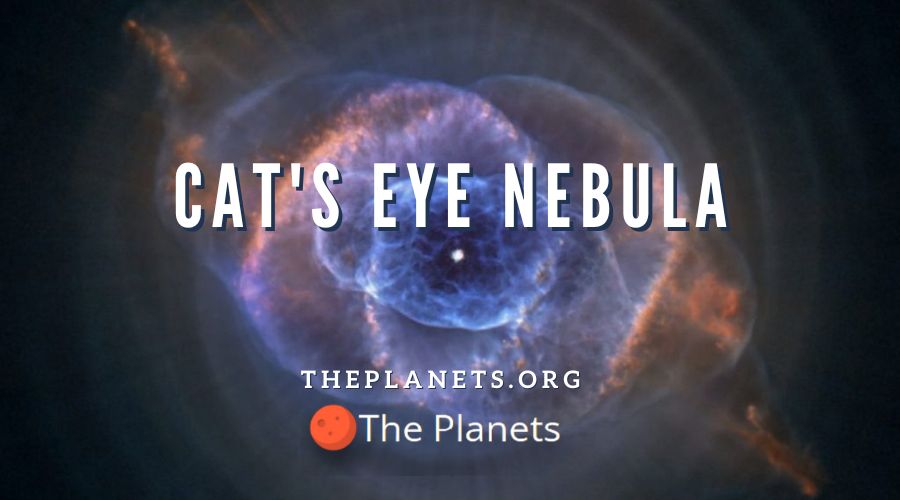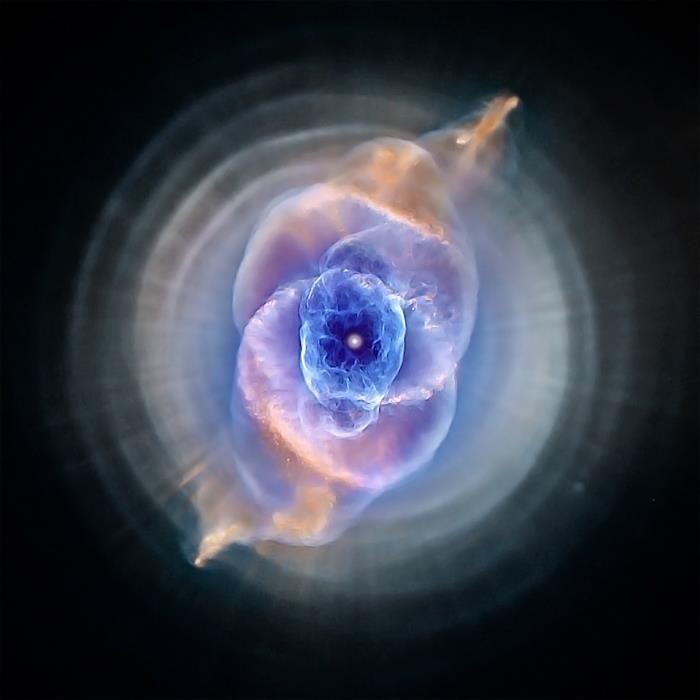
The Discovery the Cat’s Eye Nebula
The Cat’s Eye Nebula was first observed on February 15, 1786, by William Herschel. Herschel was a German-born astronomer, who emigrated to Great Britain at age 19. There he built himself a telescope and started to study astronomy. His early work was devoted to the study of planetary nebulae. In 1802 he published a catalog of over 2,500 planetary nebulae, including the Cat’s Eye Nebula.

What is a Planetary Nebula?
William Herschel decided that planetary nebulae were the birth of planetary systems. He thought the gas surrounding the stars was condensing to form planets. Many other astronomers accepted this theory, and the objects became known as planetary nebulae.
However, Herschel’s theory was wrong. No planets are being formed in a planetary nebula. Planetary nebulae arise from the death of a star. Small and medium-sized stars will burn for millions of years. As stars die, they eject matter into space. This matter forms planetary nebulae and is the last step in a star’s life. The death of a star can take tens of thousands of years. Throughout this time, the nebula grows.
How the Cat’s Eye Nebula has Evolved
The death of a star is a process that takes tens of thousands of years. As the process occurs, the shape of the nebula changes. The pulses of matter emitted from the central star of the Cat’s Eye Nebula produced the complicated shape of the nebula. The pulses occurred roughly every 1500 years and created the 11 or more concentric spheres of matter that make up the nebula. The amount of matter ejected in each pulse weighs more than all the planets in our planetary system combined.
Scientists don’t know why the Cat’s Eye Nebula emitted matter in pulses. There are a few theories. The first is that the magnetic activity of the star produced the pulses. The magnetic activity is thought to be similar to our own sun’s sunspots. Another explanation is that the dying star had a companion star. The gravity from this orbiting second star produced disturbances that lead to the pulses. The last theory is that the dying star underwent stellar pulsations, expansions and contractions in size, as it was trying to stabilize itself. The ejection of the matter might be related to specific phases of the stellar pulsation.
The Hubble Space Telescope started to observe the Cat’s Eye Nebula in the early 1990s. These observations will help astronomers understand star death and the formation of nebulae better. The Hubble images show that from 1994 to 2004 the Cat’s Eye Nebula has expanded. More nebulae must be studied before scientists have a clear understanding of why nebulae expand.
What Gases are in the Cat’s Eye Nebula?
The Cat’s Eye Nebula was the first nebula to have its chemical composition measured. William Huggins, another English astronomer, started to study the Cat’s Eye Nebula with a new type of instrument called a spectrometer. The spectrometer allowed Huggins to determine the chemical composition of various astronomical objects. On August 29, 1864, he took the first spectrum of a nebula- the Cat’s Eye Nebula. His spectrum proved that the nebula was made of gases.
When William Huggins measured the spectrum of the Cat’s Eye Nebula, he discovered some unusual lines in his spectrum. Spectral lines correspond to specific molecules and atoms, but this line did not match anything ever seen before. Scientists decided that this line arose from a new, completely unknown atom, which they called nebulium. It wasn’t until the 1920s that physicists discovered that oxygen and nitrogen ions could produce this mystery spectral line. Only in extreme circumstances, such as in a nebula, can these spectral lines be observed. These lines are called forbidden lines because they occur so infrequently.
Quick Facts About The Cat’s Eye Nebula
- The Cat’s Eye Nebula is also known as NGC6543.
- It was first discovered in 1786.
- The Cat’s Eye Nebula was the first nebula to be studied by spectroscopy (in 1864).
- It consists of 11 or more expanding spheres of gas. These spheres look like rings from our perspective.
- The Cat’s Eye Nebula was formed during the death of an intermediate-sized star.